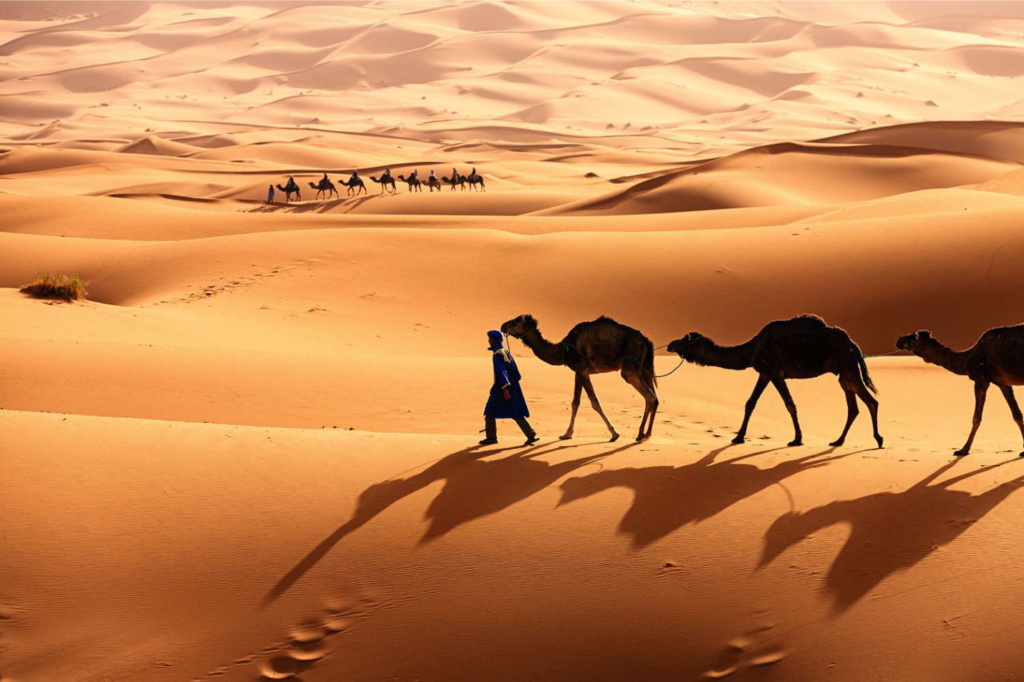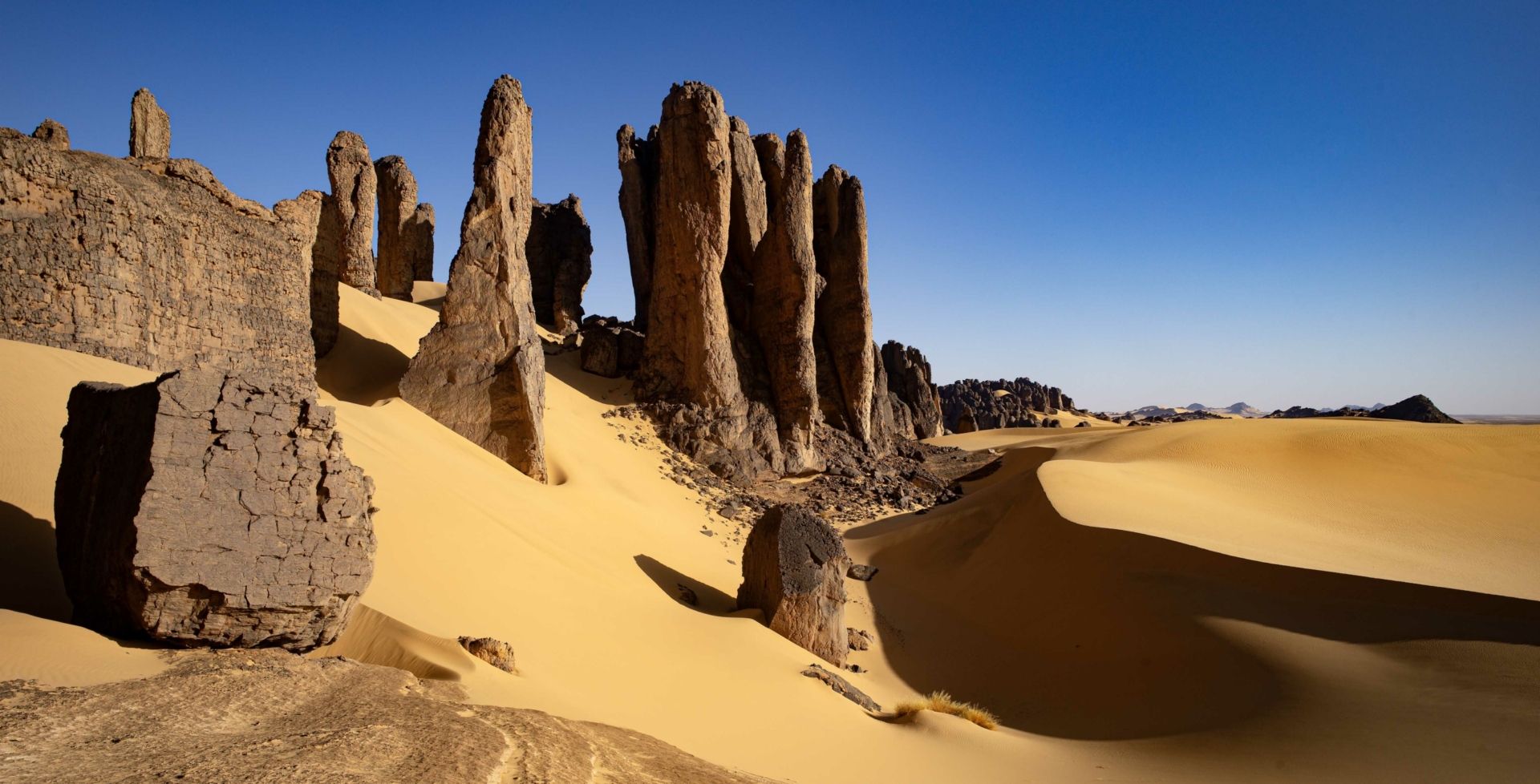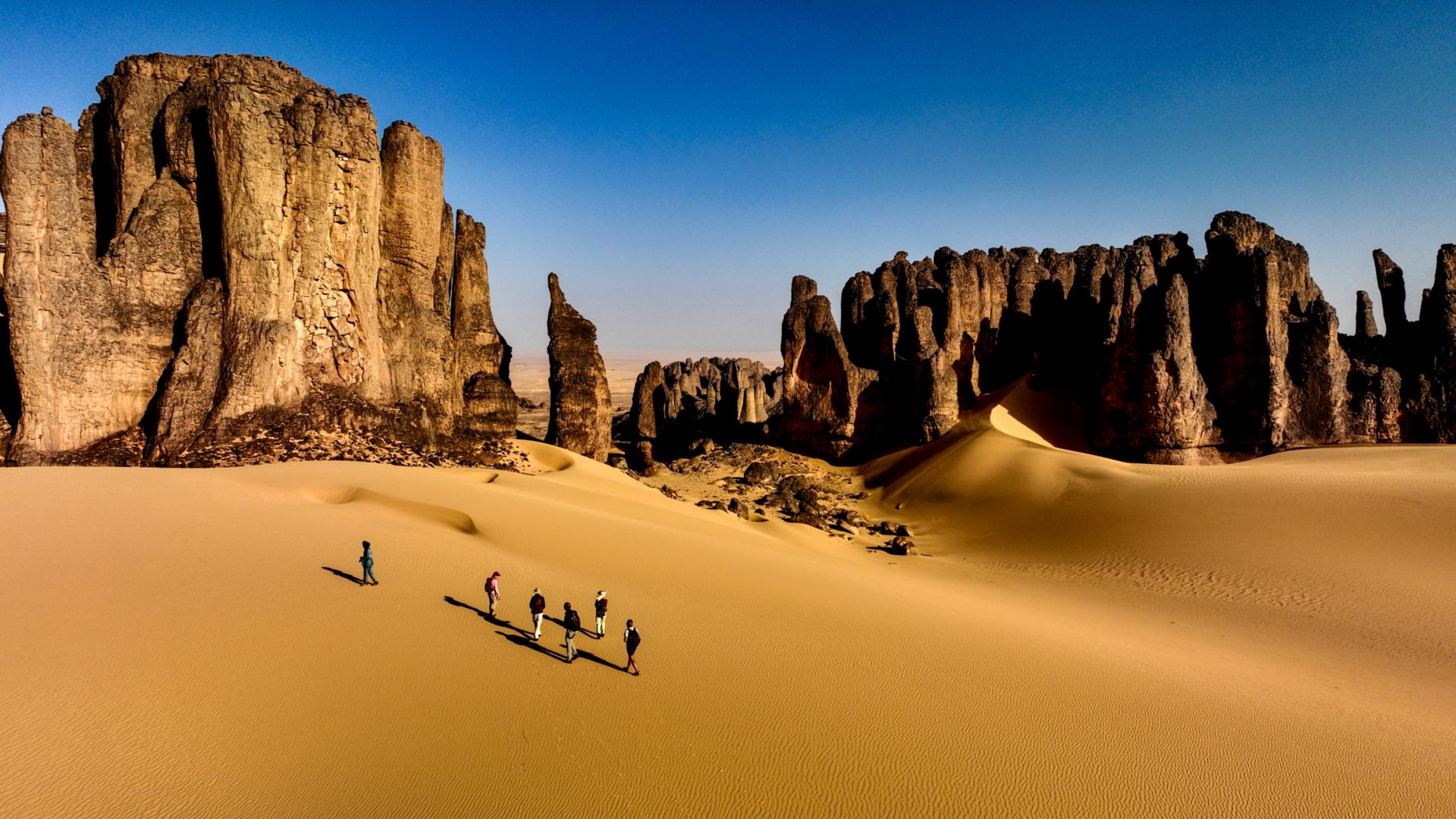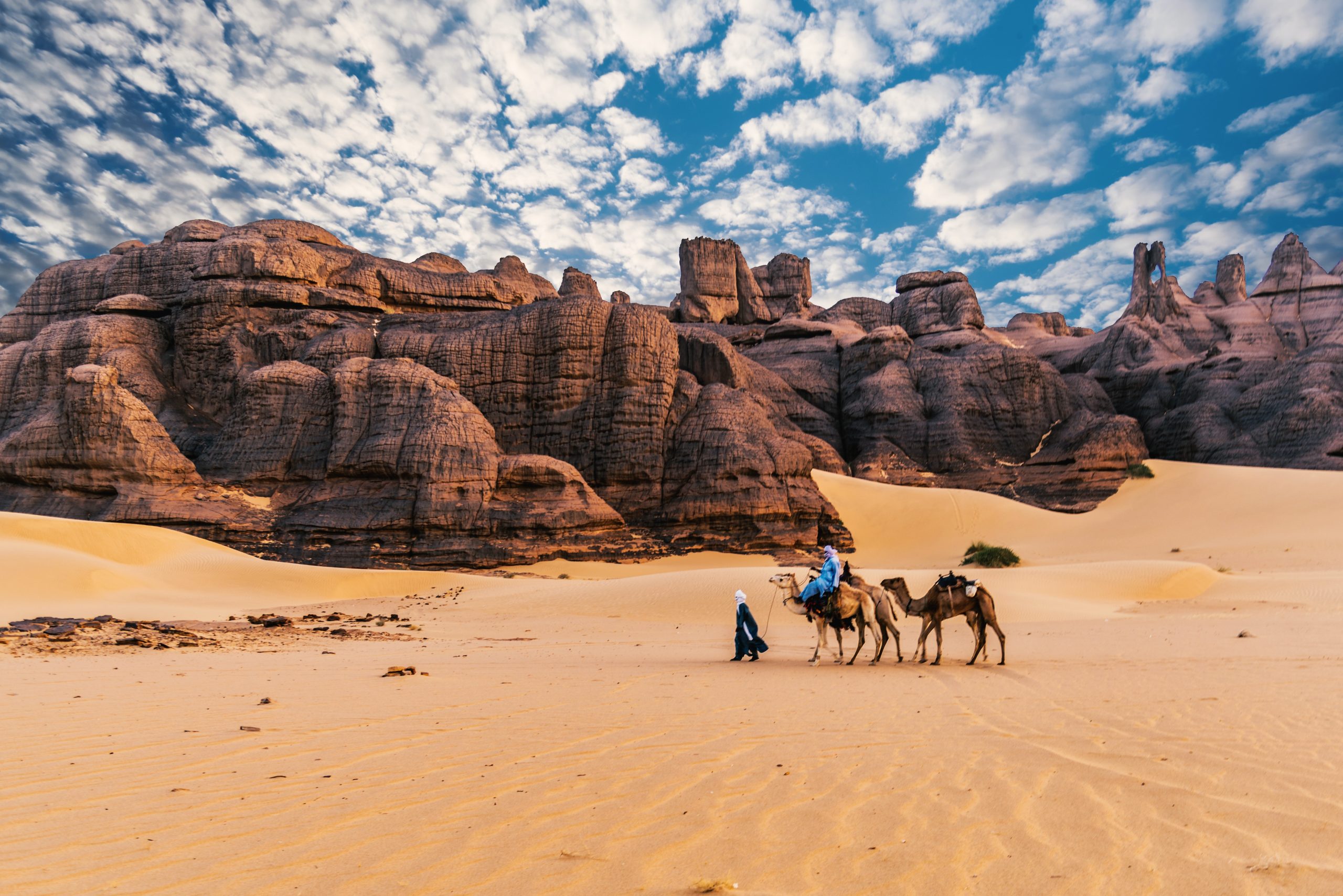ALGERIA
In the heart of the Tassilis of the Hoggar lies a hidden sanctuary of rocks and silence, where every step is a journey through time and nature. This majestic Algerian Sahara landscape, shaped over centuries, rises like stone cathedrals, bearing witness to ancient civilizations.
Starting in Youfi Aghlal, light guides us through serene paths, revealing natural formations like Tin Afaza’s towering rock “cathedrals.” Deeper into Youfi Akit, the desert’s rhythm invites meditation, with each stone whispering secrets of the past.
Further north, Tin Tarabine unveils traces of nomadic life, fragile yet resilient. This journey isn’t just an exploration—it’s an immersion into timeless beauty, reconnecting us with the essence of existence and the Earth’s profound echoes.

Reasons to Visit Algeria
Rich Historical and Cultural Heritage
Algeria is known for its ancient Roman cities like Timgad and Djemila, both UNESCO World Heritage sites. The capital, Algiers, is famous for the old medina of the Casbah, a labyrinth of alleys and historic buildings.The Sahara – A Natural Wonder
The Sahara Desert occupies a large portion of Algeria’s territory. Visitors can explore oasis towns such as Ghardaïa and Tamanrasset, or marvel at the unique rock formations in Tassili n’Ajjer.Islamic and Colonial Architecture
Algeria blends traditional Islamic architecture with French colonial influences. The Great Mosque of Algiers and colonial-era buildings are must-sees.The Mediterranean Coastline
Algeria boasts pristine beaches and picturesque coastal cities like Oran, renowned for its rai music and vibrant atmosphere.Traditional Cuisine
Algerian cuisine is a blend of Arab, Berber, and Mediterranean flavors. Popular dishes include couscous, tajine, and chakchouka.

Youfi Aghlal

Tassili

Tamanrasset
Best Time to Visit
The best time to visit Algeria is during spring (December – April) when temperatures are moderate and ideal for exploration.
Country: People’s Democratic Republic of Algeria.
Capital: Algiers.
Area: 2,381,740 km².
Population: 44.5 million inhabitants.
Political System: Republic.
Entry Requirements
Since December 2022, Algerian authorities have simplified the visa process for tourists traveling to the Sahara.
- A visa is mandatory.
- The passport must be valid for at least 6 months after the return date.
- Visa cost: €70 + €20 in fees.
Horizons Nomades handles visa procedures, provided a clear and readable copy of the passport is received in time. The process takes approximately 30 days.
Health
No mandatory vaccines, but up-to-date boosters for diphtheria, tetanus, and polio are recommended.
Currency
The official currency is the Algerian dinar (DZD).
1 Euro = 146 DZD (approximate).
Time Zone
- Summer: GMT+1.
- Winter: No time difference from GMT.
Electricity
- Voltage: 230 V.
- Plug Types: C and F (no adapter needed).
Religion
The official state religion is Sunni Islam.
Languages and Ethnic Groups
- Languages: Arabic is the official language, French is widely spoken, and Berber has been recognized as a national language since 2002.
- Ethnic Groups:
- Berbers: The oldest community in North Africa, divided into regional groups like Chaoui, Chenoui, Kabyle, Mozabite, and Chleuh. Berbers living in the mountains have preserved their language and culture, including their unique script, Tifinagh.
- Tuaregs: Known as “Blue Men” for the indigo-dyed fabric that stains their skin, they inhabit the Sahara and are admired for their resilience and rich traditions.
Geology of the Tassilis of Hoggar
The Tassilis of Hoggar, located in the Algerian Sahara, are stunning rock formations shaped over millions of years by geological and erosional processes.
Sedimentary Rock Origins:
Formed 300–500 million years ago from sediment deposits in shallow seas and rivers, compacted over time into sandstone.Tectonic Activity:
Movements during the formation of Pangaea elevated and fractured the region, exposing sandstone layers. Beneath lies a base of granite and basalt, forming the Hoggar massif.Erosional Processes:
- Wind (Aeolian Erosion): Saharan winds carved arches, pillars, and unique rock formations.
- Water (Fluvial Erosion): Past wet periods during the Quaternary era (2.5 million to 10,000 years ago) further sculpted the landscape.
- Thermal Stress: Extreme temperature variations cause rock fracturing.
The result is a plateau with deep gorges, canyons, and labyrinthine rock structures. The area also features prehistoric rock art, evidence of ancient human habitation.
Climate
- Dry Conditions: Occasional light rain (1–2 times yearly).
- Temperatures:
- November to March: 20°C–28°C during the day, dropping to 0°C at night.
- October and April: Daytime temperatures up to 35°C, nighttime 5°C–10°C.
While the climate is predictable, occasional extremes are possible. For forecasts, visit: Weather Updates.
Best Time to Visit
From autumn to spring.
Geography
Algeria is Africa’s second-largest country and the 10th largest globally.
- North: Parallel ranges of the Tell and Saharan Atlas with vast plains and plateaus.
- Sahara: Covers over 80% of the country, featuring rocky plateaus (regs), sand dunes (ergs), oases, and mountain ranges like the Hoggar (highest peak: 3,003 m).
- Tassili n’Ajjer: A lunar-like landscape of eroded rock formations and sand dunes, rising over 1,000 m in elevation.
Group
From 7 to 12 people.
Luggage
To make handling easier, it is best to opt for a classic backpack or a soft bag. Checked luggage should not exceed 23 kilograms. During the flight, use a backpack for fragile and essential items (camera, phone, travel books, etc.). The new regulations prohibit the presence of liquids.
Transportation
During the hike, after reaching the sites, there are one or two short transfers by all-terrain vehicle to move between sites. A kitchen vehicle accompanies the group and meets them at prearranged locations with the guide for lunch and dinner.
Level
The walks are easy (5 to 6 hours of walking per day) and do not require carrying heavy loads. Bring a small daypack with personal items.
During the tours, meals are prepared using local products:
- Breakfasts: Coffee, tea, bread, jam, butter, etc.
- Lunches: Vegetable salads (tomatoes, cucumbers, beets, eggs, corn, etc.)
- Dinners: Hot cooked dishes (soup, rice, pasta, etc.).
Gastronomy
- Soups: Chorba is made with mutton, vegetables, aromatic herbs, spices, and tomatoes, cooked slowly for several hours. In the final moments, m’katfa (hand-rolled vermicelli) or frik (crushed wheat grains) is added to the broth.
- Couscous: This is undoubtedly the most famous specialty abroad. It consists of semolina moistened with water and a little oil, sifted, and hand-rolled. It is steamed in a couscoussier, with the lower section containing a variety of vegetables (cabbage, turnips, carrots, zucchini, eggplant, tomatoes, onions, chickpeas) and meat (beef, mutton, or chicken). The dish is served hot, topped with sauce and vegetables. Variants include replacing the sauce with fava beans and peas or with raisins and powdered sugar. To fully enjoy couscous, it is best accompanied by buttermilk or leben.
- Chakchouka: A dish of grilled peppers and tomatoes, simmered in a sauce made of garlic, onions, red pepper, and oil. Depending on the region, one or two eggs may be added. It is a flavorful dish with a delicate aroma.
Water
There is enough water for cooking and drinking, but it is limited for washing.
Site Protection
Each participant is responsible for keeping the visited sites clean. Do not leave anything behind (paper, plastic, batteries, etc.) as the ecological balance of these areas is fragile, and the constant flow of tourists increases the risk of degradation.
Insurance
You must take out health insurance in your home country to visit Algiers.
Clothing
(For men and women, avoid tight or short clothing)
- Light shirts, long-sleeve T-shirts
- A long-sleeve sweater for evenings
- Warm pajamas for nights from December to February (for children, bring a hat for the night)
- Loose-fitting pants
- A windbreaker
- A hat
Footwear
- A pair of walking shoes (e.g., hiking boots)
- A pair of sandals
Essential Accessories
- A good sleeping bag
- Sunglasses
- A 1-liter water bottle
- A small day backpack
- A headlamp with batteries
- A multi-purpose knife (to be packed in checked luggage)
Toiletry Kit
- Sunscreen
- Cleansing milk
- Lip balm
- Wet wipes
- Toilet paper + lighter
Photo/Video
For digital devices, recharging is available at the camp. Don’t forget to bring your cables.






